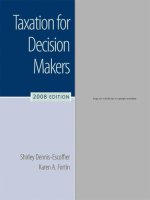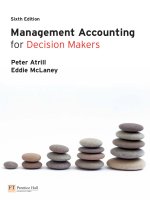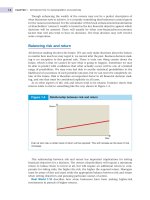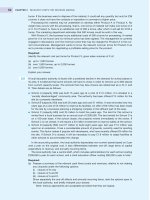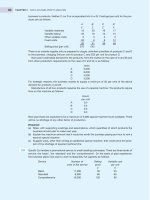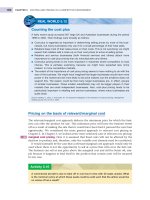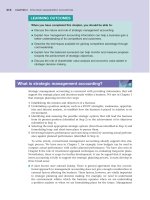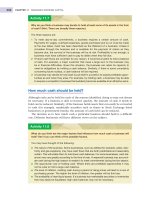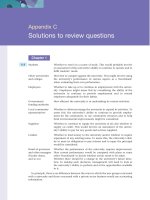Financial accounting for decision makers 5e peter atrill and eddie mclaney
Bạn đang xem bản rút gọn của tài liệu. Xem và tải ngay bản đầy đủ của tài liệu tại đây (3.4 MB, 484 trang )
Financial Accounting
for Decision Makers
Fifth Edition
Fifth Edition
Peter Atrill Eddie McLaney
Fifth Edition
Financial Accounting for Decision Makers
‘The book is written in a very friendly way,
from which students will benefit.’
Paulo Alves, University of Lancaster
A comprehensive yet accessible introduction to the subject, Financial Accounting for Decision Makers focuses on
the ways in which financial statements and information can be used to improve the quality of decision making. By
introducing topics gradually and explaining technical terminology in a clear, friendly style, the authors cater both
for accounting students, and for those studying entry-level accounting within another field. A practical emphasis
throughout the book ensures that the material is always relevant and suitable to the decision makers of the future.
Audience
Suitable for all those studying an introductory
course in financial accounting, who are seeking
an understanding of basic principles and underlying
concepts without detailed technical knowledge.
Features
●
●
Authors
Peter Atrill is a freelance academic and author
working with leading institutions in the UK, Europe
and SE Asia. He was previously Head of Business
and Management at the University of Plymouth
Business School.
Eddie McLaney is Visiting Fellow in Accounting
and Finance at the University of Plymouth.
Visit the companion website at
www.pearsoned.co.uk/atrillmclaney
●
●
●
●
9780273712756_05_COVER.indd 1
Numerous activities and exercises enable
you to constantly test your understanding
and reinforce learning.
Newly expanded coverage of the analysis
and interpretation of financial statements
reinforces the decision-making focus.
NEW chapter on corporate governance
outlines the issues and potential problems
inherent to the separation of ownership of
a company from day-to-day control.
Colourful and relevant examples from the
real world, including company reports
and survey data, demonstrate the practical
application and value of concepts and
techniques learnt.
Key terms, glossary and bulleted
summaries are excellent revision aids.
www.pearson-books.com
Cover photograph © Getty Images
an imprint of
Fully integrated coverage of International
Financial Reporting Standards (IFRS).
Peter Atrill
Eddie McLaney
Peter Atrill
Eddie McLaney
●
Interactive ‘open-learning’ style, ideal for
self-study, encourages you to check your
progress continually.
Financial Accounting
for Decision Makers
28/8/07 15:37:00
FINA_A01.qxd
9/21/07
11:37 AM
Page i
Financial Accounting
for Decision Makers
Visit the Financial Accounting for Decision Makers,
fifth edition Companion Website with Grade Tracker at
www.pearsoned.co.uk/atrillmclaney to find valuable
student learning material including:
l
l
l
l
l
Self assessment questions with Grade Tracker function
to test your learning and monitor your progress
A study guide to aid self-learning
Revision questions and exercises to help you check
your understanding
Extensive links to valuable resources on the web
Comments on case studies to aid interpretative and
analytical skills
FINA_A01.qxd
9/21/07
11:37 AM
Page ii
We work with leading authors to develop the strongest
educational materials in accounting, bringing cutting-edge
thinking and best learning practice to a global market.
Under a range of well-known imprints, including
Financial Times Prentice Hall, we craft high-quality print
and electronic publications which help readers to
understand and apply their content, whether studying
or at work.
To find out more about the complete range of our
publishing, please visit us on the World Wide Web at:
www.pearsoned.co.uk
FINA_A01.qxd
9/21/07
11:37 AM
Page iii
5th
Edition
Financial Accounting
for Decision Makers
Peter Atrill
and
Eddie McLaney
FINA_A01.qxd
9/21/07
11:37 AM
Page iv
Pearson Education Limited
Edinburgh Gate
Harlow
Essex CM20 2JE
England
and Associated Companies throughout the world
Visit us on the World Wide Web at:
www.pearsoned.co.uk
Second edition published 1999 by Prentice Hall Europe
Third edition published 2002 by Pearson Education Limited
Fourth edition 2005
Fifth edition 2008
© Prentice Hall Europe 1996, 1999
© Pearson Education Limited 2002, 2008
The rights of Peter Atrill and Eddie McLaney to be identified as authors of this work
have been asserted by them in accordance with the Copyright, Designs
and Patents Act 1988.
All rights reserved. No part of this publication may be reproduced, stored in a
retrieval system, or transmitted in any form or by any means, electronic, mechanical,
photocopying, recording or otherwise, without either the prior written permission of
the publisher or a licence permitting restricted copying in the United Kingdom issued
by the Copyright Licensing Agency Ltd, Saffron House, 6–10 Kirby Street, London EC1N 8TS.
All trademarks used herein are the property of their respective owners. The use of
any trademark in this text does not vest in the author or publisher any trademark
ownership rights in such trademarks, nor does the use of such trademarks imply any
affiliation with or endorsement of this book by such owners.
ISBN: 978-0-273-71275-6
British Library Cataloguing-in-Publication Data
A catalogue record for this book is available from the British Library
10 9 8 7 6 5 4 3 2 1
11 10 09 08 07
Typeset in 9.5/12.5pt Stone Serif by 35
Printed and bound by Mateu Cromo Artes Graficas, Spain
The publisher’s policy is to use paper manufactured from sustainable forests.
FINA_A01.qxd
9/21/07
11:37 AM
Page v
Brief contents
Guided tour of the book
xii
Guided tour of the Companion Website
xiv
Preface
xvii
How to use this book
xix
Acknowledgements
xxi
1 Introduction to accounting
1
2 Measuring and reporting financial position
29
3 Measuring and reporting financial performance
64
4 Accounting for limited companies (1)
108
5 Accounting for limited companies (2)
142
6 Measuring and reporting cash flows
173
7 Analysing and interpreting financial statements (1)
203
8 Analysing and interpreting financial statements (2)
242
9 Reporting the financial results of groups of companies
274
10 Governing a company
321
Appendix A Recording financial transactions
372
Appendix B Glossary of key terms
390
Appendix C Solutions to self-assessment questions
400
Appendix D Solutions to review questions
409
Appendix E Solutions to selected exercises
418
Index
451
FINA_A01.qxd
9/21/07
11:37 AM
Page vi
Supporting resources
Visit www.pearsoned.co.uk/atrillmclaney to find valuable online resources
Companion Website for students
l
l
l
l
l
Self assessment questions with Grade Tracker function to test your learning
and monitor your progress
A study guide to aid self-learning
Revision questions and exercises to help you check your understanding
Extensive links to valuable resources on the web
Comments on case studies to aid interpretative and analytical skills
For instructors
l
l
l
l
l
l
Complete, downloadable Instructor’s Manual
PowerPoint slides that can be downloaded and used for presentations
Progress tests, consisting of various questions and exercise material with
solutions
Additional international case studies
Tutorial/seminar questions and solutions
Solutions to individual chapter exercises
Also: The Companion Website with Grade Tracker provides the following
features:
l
l
Search tool to help locate specific items of content
Online help and support to assist with website usage and troubleshooting
For more information please contact your local Pearson Education sales
representative or visit www.pearsoned.co.uk/atrillmclaney
FINA_A01.qxd
9/21/07
11:37 AM
Page vii
Contents
Guided tour of the book
Guided tour of the Companion Website
Preface
How to use this book
Acknowledgements
1
xii
xiv
xvii
xix
xxi
Introduction to accounting
1
Introduction
Learning outcomes
1
1
What is accounting?
Who are the users of accounting information?
The conflicting interests of users
How useful is accounting information?
Providing a service
But . . . is it material?
Weighing up the costs and benefits
Accounting as an information system
Management and financial accounting
Scope of this book
Has accounting become too interesting?
The changing face of accounting
What kinds of business ownership exist?
How are businesses organised?
What is the financial objective of a business?
Not-for-profit organisations
2
2
4
4
6
7
8
10
12
13
14
16
17
19
20
24
Summary
Key terms
Reference
Further reading
Review questions
25
26
26
27
28
2 Measuring and reporting financial position
29
Introduction
Learning outcomes
29
29
The
The
The
The
30
34
40
42
major financial statements – an overview
balance sheet
effect of trading operations on the balance sheet
classification of assets
FINA_A01.qxd
viii
9/21/07
11:37 AM
Page viii
CONTENTS
The classification of claims
Balance sheet layouts
The balance sheet and time
Accounting conventions and the balance sheet
Money measurement
Valuing assets on the balance sheet
Interpreting the balance sheet
44
45
47
48
50
53
58
Summary
Key terms
Further reading
Review questions
Exercises
58
60
60
61
61
3 Measuring and reporting financial performance
Introduction
Learning outcomes
64
64
64
The income statement
The income statement and the balance sheet
The income statement layout
Some further issues
Recognising revenue
Recognising expenses
Depreciation
Tangible non-current assets (property, plant and equipment)
Depreciating intangible assets
Depreciation and the replacement of non-current assets
Depreciation and judgement
Costing inventories
Dealing with trade receivables problems
Interpreting the income statement
65
66
67
68
71
75
80
80
87
88
88
90
95
100
Summary
Key terms
Further reading
Review questions
Exercises
100
102
102
103
103
4 Accounting for limited companies (1)
108
Introduction
Learning outcomes
108
108
The main features of limited companies
Managing a company
Financing limited companies
Altering the nominal value of shares
Raising share capital
Borrowings
Withdrawing equity
The main financial statements
Dividends
109
116
116
121
124
124
126
130
132
FINA_A01.qxd
9/21/07
11:37 AM
Page ix
CONTENTS
Summary
Key terms
Further reading
Review questions
Exercises
5 Accounting for limited companies (2)
133
135
135
136
136
142
Introduction
Learning outcomes
142
142
The directors’ duty to account
The need for accounting rules
Sources of accounting rules
Presenting the financial statements
The framework of principles
The auditors’ role
Directors’ report
Segmental financial reports
Narrative reporting
Summary financial statements
Creative accounting
Summary
Key terms
Further reading
Review questions
Exercises
143
144
144
147
152
153
154
154
158
162
163
168
169
169
170
170
6 Measuring and reporting cash flows
173
Introduction
Learning outcomes
173
173
The cash flow statement (or statement of cash flows)
The main features of the cash flow statement
The form of the cash flow statement
The normal direction of cash flows
Preparing the cash flow statement
What does the cash flow statement tell us?
174
176
178
181
182
189
Summary
Key terms
Further reading
Review questions
Exercises
193
193
194
195
195
7 Analysing and interpreting financial statements (1)
203
Introduction
Learning outcomes
203
203
Financial ratios
Financial ratio classifications
The need for comparison
Calculating the ratios
204
205
205
207
ix
FINA_A01.qxd
x
9/21/07
11:37 AM
Page x
CONTENTS
A brief overview
Profitability
Efficiency
The relationship between profitability and efficiency
Liquidity
Operating cash cycle (OCC)
Financial gearing
209
210
215
220
222
224
226
Summary
Key terms
Further reading
Review questions
Exercises
233
234
234
235
235
8 Analysing and interpreting financial
statements (2)
242
Introduction
Learning outcomes
242
242
Alexis plc
Investment ratios
Financial ratios and the problem of overtrading
Trend analysis
Common-size financial statements
Using ratios to predict financial failure
Limitations of ratio analysis
243
243
251
252
254
258
263
Summary
Key terms
References
Further reading
Review questions
Exercises
265
265
266
266
267
267
9 Reporting the financial results of groups
of companies
274
Introduction
Learning outcomes
274
274
What is a group of companies?
Why do groups exist?
Types of group relationship
Preparation of a group balance sheet
Goodwill arising on consolidation and balance sheet values
Inter-company assets and claims
Preparing the group income statement
Inter-company trading
Group cash flow statements
Accounting for less than a controlling interest – associate companies
The argument against consolidation
275
275
281
283
301
304
305
307
307
309
312
Summary
Key terms
313
314
FINA_A01.qxd
9/21/07
11:37 AM
Page xi
CONTENTS
Further reading
Review questions
Exercises
10 Governing a company
314
315
315
Introduction
Learning outcomes
Corporate governance
The board of directors
The Combined Code
The tasks of the board
Chairing the board
The role of non-executive directors
The audit process
Assessing board performance
Remunerating directors
Setting performance targets
Total shareholder return
Economic value added (EVA®)
Earnings per share
Directors’ share options
Deciding on a target
The rise of shareholder activism
Complying with the Combined Code
Summary
Key terms
References
Further reading
Review questions
Exercises
321
321
321
322
323
324
327
328
332
336
344
345
349
349
352
355
355
360
361
367
368
370
370
370
371
371
Appendix A Recording financial transactions
372
Introduction
Learning outcomes
The basics of double-entry bookkeeping
Recording trading transactions
Balancing accounts and the trial balance
Preparing the financial statements (final accounts)
The ledger and its division
Summary
Key terms
Further reading
Exercises
372
372
373
375
378
382
385
386
386
387
388
Appendix B
Appendix C
Appendix D
Appendix E
390
400
409
418
Index
Glossary of key terms
Solutions to self-assessment questions
Solutions to review questions
Solutions to selected exercises
451
xi
FINA_A01.qxd
9/21/07
11:37 AM
Page xii
Guided tour of the book
36
CHAPTER 2
Activities These short
questions, integrated
throughout each
chapter, allow you
to check your
understanding as you
progress through the
text. They comprise
either a narrative
question requiring you
to review or critically
consider topics, or a
numerical problem
requiring you to deduce
a solution. A suggested
answer is given
immediately after each
activity.
MEASURING AND REPORTING FINANCIAL POSITION
The sorts of items that often appear as assets in the balance sheet of a business
include:
2
l property;
l plant and equipment;
l fixtures and fittings;
l patents and trademarks;
l trade receivables (debtors);
Measuring and reporting
financial position
l investments.
Activity 2.3
Can you think of three additional items that might appear as assets in the balance sheet
of a business?
You may be able to think of a number of other items. Some that you may have identified are:
Introduction
l
l
e saw in the previous chapter that accounting has two distinct strands –
financial accounting and management accounting. This chapter, along with
Chapters 3 to 6, will examine the three major financial statements that form the core
of financial accounting. We start by taking an overview of these statements to see
how each contributes towards an assessment of the overall financial position and
performance of a business.
Following this overview, we begin a more detailed examination by turning our
attention towards one of these financial statements – the balance sheet. We shall
see how it is prepared, and examine the principles underpinning this statement.
We shall also consider its value for decision-making purposes.
W
l
l
‘
‘
motor vehicles;
inventories (stock);
computer equipment;
cash at bank.
Note that an asset does not have to be a physical item – it may also be a nonphysical right to certain benefits. Assets that have a physical substance and can be
touched are referred to as tangible assets. Assets that have no physical substance but
which, nevertheless, provide expected future benefits (such as patents) are referred to
as intangible assets.
Claims
Learning outcomes
A claim is an obligation on the part of the business to provide cash, or some other form
of benefit, to an outside party. A claim will normally arise as a result of the outside
party providing funds in the form of assets for use by the business. There are essentially
two types of claim against a business:
When you have completed this chapter, you should be able to:
l
Explain the nature and purpose of the three major financial statements.
l
Prepare a simple balance sheet and interpret the information that it contains.
l
Discuss the accounting conventions underpinning the balance sheet.
l
Discuss the limitations of the balance sheet in portraying the financial position
of a business.
‘
l Capital. This represents the claim of the owner(s) against the business. This claim is
sometimes referred to as the owner’s equity. Some find it hard to understand how the
owner can have a claim against the business, particularly when we consider the
example of a sole-proprietor-type business where the owner is, in effect, the business. However, for accounting purposes, a clear distinction is made between the
business (whatever its size) and the owner(s). The business is viewed as being quite
separate from the owner and this is equally true for a sole proprietor like Paul, the
wrapping-paper seller in Example 2.1, or a large company like Marks and Spencer
plc. It is seen as a separate entity with its own separate existence and when financial
statements are prepared, they relate to the business rather than to the owner(s). This
means that the balance sheet should reflect the financial position of the business as
a separate entity. Viewed from this perspective, any funds contributed by the owner
will be seen as coming from outside the business and will appear as a claim against
the business in its balance sheet.
Key terms The key
concepts and
techniques in each
chapter are highlighted
in colour where they are
first introduced, with
an adjacent icon in the
margin to help you refer
back to them.
Learning outcomes Bullet points at the start of each chapter show what you
can expect to learn from that chapter, and highlight the core coverage.
NARRATIVE REPORTING
and overseas. Failure to compete with competitors on areas including price, product range, quality
and service could have an adverse effect on the Group’s financial results.
We aim to have a broad appeal in price, range and store format in a way that allows us to compete in different markets. We track performance against a range of measures that customers tell
us are critical to their shopping trip experience. We constantly monitor customer perceptions of
ourselves and our competitors to ensure that we can respond quickly if we need to.
161
PREPARING THE CASH FLOW STATEMENT
187
Example 6.3
Torbryan plc’s income statement for the year ended 31 December 2007 and the
balance sheets as at 31 December 2006 and 2007 are as follows:
Income statement for the year ended 31 December 2007
Source: 2006 Annual Report Tesco plc, p. 14.
This element also requires a commentary on key relationships with stakeholders, apart
from shareholders, that may affect the performance of the business and its value. The
stakeholders may include customers, suppliers, employees, contractors, lenders as well
as other businesses with which the business has strategic alliances. Real World 5.5
reveals how, in the 2006 OFR, Tesco plc describes the relationship with its customers.
Real World 5.5
Every little helps
Our customers have told us what they want from an ‘every little helps’ shopping trip and this year
12,000 of them attended our Customer Question Times to offer ideas on how we can improve.
Clubcard also helps us to understand what our customers want, whilst allowing us to thank them
for shopping with us – this year we gave away £320 m in Clubcard vouchers.
We don’t always get it right but we try to make their shopping trip as easy as possible, reduce
prices where we can to help them spend less and give them the convenience of shopping where
and when they want – in small stores, large stores or on-line.
Source: 2006 Annual Report Tesco plc, p. 14.
4. Financial position
This final element of the OFR framework should describe events that have influenced
the financial position of the business during the year and those that are likely to affect
the business in the future. It should also include a discussion of the capital structure,
cash flows and liquidity of the company. Real World 5.6 reveals how Tesco plc comments
on its cash flows.
Real World 5.6
Tesco’s cash
Tesco’s 2006 OFR contains the following comment concerning its cash flows.
The Group generated net cash of £165 m during the year, benefiting from strong cash flow from
operating activities of £3.4 bn and the net proceeds of £346 m from our property joint venture with
Concensus. Within this, £239 m of cash was released from working capital, which was £199 m
lower than last year. This was mainly due to a smaller rise in trade creditors (payables) than last
year (last year’s increase was exceptionally large and the change in International year end reduced
trade creditors), higher non-food stocks (linked to global sourcing) and increased debtors (resulting
from advance rent on new leasehold stores in Korea).
£m
576
(307)
269
(65)
(26)
178
21
199
17
216
(23)
193
(46)
147
Revenue
Cost of sales
Gross profit
Distribution expenses
Administrative expenses
Other operating income
Operating profit
Interest receivable
Interest payable
Profit before taxation
Taxation
Profit for the year
Balance sheets as at 31 December 2006 and 2007
Non-current assets
Property, plant and equipment
Land and buildings
Plant and machinery
Current assets
Inventories
Trade receivables
Total assets
Equity
Called-up ordinary share capital
Share premium account
Retained earnings
Non-current liabilities
Borrowings – Loan notes
Current liabilities
Borrowings (all bank overdraft)
Trade payables
Taxation
Total equity and liabilities
2006
£m
2007
£m
241
309
550
241
325
566
44
121
165
715
41
139
180
746
150
–
26
176
200
40
123
363
400
250
68
55
16
139
715
56
54
23
133
746
Source: 2006 Annual Report Tesco plc, p. 4.
‘Real World’ illustrations Integrated throughout the text, these illustrative examples highlight the
practical application of accounting concepts and techniques by real businesses, including extracts
from company reports and financial statements, survey data and other insights from business.
Examples At frequent
intervals throughout
most chapters, there
are numerical examples
that give you step-bystep workings to follow
through to the solution.
FINA_A01.qxd
9/21/07
11:37 AM
Page xiii
GUIDED TOUR OF THE BOOK
xiii
Self-assessment questions Towards the end of most chapters you will encounter one of these questions,
allowing you to attempt a comprehensive question before tackling the end-of-chapter assessment material.
To check your understanding and progress, solutions are provided at the end of the book.
232
CHAPTER 7
368
ANALYSING AND INTERPRETING FINANCIAL STATEMENTS (1)
CHAPTER 10
Self-assessment question 7.1
Summary
Both Ali plc and Bhaskar plc operate electrical stores throughout the UK. The financial
statements of each business for the year ended 30 June 2007 are as follows:
The main points of this chapter may be summarised as follows:
Non-current liabilities
Borrowings – Loan notes
Current liabilities
Trade payables
Taxation
Total equity and liabilities
l Corporate governance issues arise because of the separation of ownership from
Bhaskar plc
£000
control of the company.
l Corporate governance rules are based around the principles of disclosure, account-
ability and fairness.
510.0
91.2
601.2
l The Combined Code, which apples to UK Stock Exchange listed companies, adopts
a ‘comply-or-explain’ approach to the rules that it sets out.
The board of directors
403.0
321.9
91.6
816.5
1,417.7
l The board governs the company on behalf of the shareholders.
l The board is responsible for setting the strategic direction of the company, control-
ling the company and nurturing relations with shareholders and other parties.
l The chairman must lead and manage the board of directors.
320.0
367.6
687.6
250.0
624.6
874.6
l The chairman’s role involves ensuring that the board operates effectively, providing
190.0
250.0
l The board is made up of executive and non-executive directors, all of which have
406.4
16.0
422.4
1,300.0
275.7
17.4
293.1
1,417.7
advice and support to directors, communicating with shareholders, and ensuring
that the performance of the board and the directors is subject to regular scrutiny.
the same legal obligation to the shareholders of the company.
Non-executive directors
l Are part-time and do not engage in the day-to-day running of the company.
l This more detached role allows them to take a more objective view of the issues
Income statements for the year ended 30 June 2007
Revenue
Cost of sales
Gross profit
Operating expenses
Operating profit
Interest payable
Profit before taxation
Taxation
Profit for the year
Ali plc
£000
1,478.1
(1,018.3)
459.8
(308.5)
151.3
(19.4)
131.9
(32.0)
99.9
confronting the company.
Bhaskar plc
£000
1,790.4
(1,214.9)
575.5
(408.6)
166.9
(27.5)
139.4
(34.8)
104.6
l Non-executive directors are meant to contribute to the main tasks of the board
identified earlier and will play a key role in board committees concerned with the
nomination of directors, the remuneration of executive directors and the integrity
of financial statements.
l The role of non-executive directors contains the potential for conflict between the
need to work with executive directors as part of a team and the need to monitor and
assess the performance of executive directors on behalf of the shareholders.
The audit process
l An external audit is required by all but the smallest companies.
All purchases and sales were on credit.
l External auditors are appointed by, and report to, the shareholders and their role is
Required:
For each business, calculate two ratios that are concerned with each of the following aspects:
l
l
l
l
Bullet point chapter
summary Each chapter
ends with a ‘bullet-point’
summary. This highlights
the material covered in
the chapter and can be
used as a quick reminder
of the main issues.
Corporate governance
Balance sheets as at 30 June 2007
Ali plc
£000
Non-current assets
Property, plant and equipment (cost less depreciation)
Land and buildings
360.0
Fixtures and fittings
87.0
447.0
Current assets
Inventories
592.0
Trade receivables
176.4
Cash at bank
84.6
853.0
Total assets
1,300.0
Equity
£1 ordinary shares
Retained profit
GOVERNING A COMPANY
to examine the annual financial statements that have been prepared by the directors.
l Many large companies have an internal audit function, the main purpose of which is
profitability;
efficiency;
liquidity; and
gearing (eight ratios in total).
to provide the directors with reassurance concerning the reliability of the company’s
control and financial reporting systems.
l The presence of internal auditors can help the external auditors, who may be able to
place reliance on some of the work undertaken by them.
What can you conclude from the ratios that you have calculated?
l The Combined Code states that an audit committee should be created with delegated
authority for ensuring that financial reporting and internal control principles are
The answer to this question can be found at the back of the book on p. 405.
Key terms summary At the end of each chapter, there is a listing (with
page references) of all the key terms introduced in that chapter, allowing
you to refer back easily to the most important points.
370
CHAPTER 10
EXERCISES
GOVERNING A COMPANY
‘
Key terms
Combined Code p. 323
Chairman p. 323
Executive directors p. 323
Non-executive directors p. 323
Executive committee p. 323
Chief executive officer p. 327
Audit committee p. 327
Risk management committee p. 327
Nomination committee p. 327
Remuneration committee p. 327
External audit p. 336
Internal audit p. 337
Total shareholder return (TSR) p. 349
Economic value added (EVA®)
p. 352
Directors’ share options p. 355
Review questions
Answers to these questions can be found at the back of the book on pp. 416–17.
9.1
When does a group relationship arise and what are its consequences for accounting?
9.2
What does a group balance sheet show?
9.3
Quite often, when an existing company wishes to start a new venture, perhaps to produce a
new product or render a new service, it will form a subsidiary company as a vehicle for the new
venture. Why is this, why not have the new venture conducted by the original company?
9.4
What is an associated company and what are the consequences for accounting of one
company being the associated company of a group of companies?
References
1 OECD (1998) Corporate Governance: Improving Competitiveness and Access to Capital in Global
Markets, report by Business Sector Advisory Group on Corporate Governance, Organisation
for Economic Co-operation and Development (OECD), p. 14.
Exercises
2 ‘Non-executive Directors’ Pay Jumps 38%’, FT.com, 6 December 2004.
Exercises 9.1 to 9.4 are more advanced that 9.5 to 9.8. Those with a coloured number have
answers at the back of the book, starting on p. 441.
3 Haigney, N., ‘Relationship Between Audit Committee and Internal Audit’, HM Treasury,
www.nationalschools.gov.uk.
4 Independent Audit Ltd, Audit Committee Reporting in 2005, www.boydeninterim.co.uk.
5 ‘UK Audit Committees More Confident and Involved Than US Counterparts’, Audit
Committee Quarterly, Issue 11. Audit Committee Institute.
9.1
Giant plc bought a majority shareholding in Jack Ltd, on the 31 March. On that date the balance
sheet of the two companies were as follows:
Balance sheets as at 31 March
6 Sulkowicz, K. (2003) ‘New Organisational and Psychological Challenges of the Audit
Committee’, Audit Committee Quarterly, Issue 8. Audit Committee Institute.
7 Reported in Tucker, S. (2005) ‘UK Chiefs Reluctant to Take on Audit Role’, FT.com,
30 January.
8 Richards, M. (2006) ‘More Link Directors Pay to Performance’, FT.com, 18 December.
9 Pope, P. and Young, S., ‘Executive Share Options: An Investor’s Guide’, www.manifest.co.uk.
10 Bender, R. (2005) ‘Just Rewards for a New Approach to Pay’, Financial Times, 2 June.
11 Buffet, W. (1985) Annual Report to Shareholders, Berkshire Hathaway, Inc., p. 12.
12 Monks, R. and Minow, N. (2001) Corporate Governance, 2nd edn, Blackwell, p. 226.
13 Quoted in Guerrera, F. (2006) ‘Study Links Directors to Options Scandal’, Financial Times,
18 December.
Further reading
If you would like to explore the topics covered in this chapter in more depth, we recommend the
following books:
Elliott, B. and Elliott, J. (2006) Financial Accounting and Reporting, 11th edn, Financial Times
Prentice Hall, Chapter 30.
Stiles, P. and Taylor, B. (2001) Boards at Work, Oxford University Press, Chapters 4–6.
Monks, R. and Minow, N. (2001) Corporate Governance, 2nd edn, Blackwell Publishing, Chapters
2–4.
Kothari, J. and Barone, E. (2006) Financial Accounting: An International Approach, Financial Times
Prentice Hall, Chapters 17 and 18.
Further reading This section comprises a
listing of relevant chapters in other textbooks
that you might refer to in order to pursue a topic
in more depth or gain an alternative perspective.
References Provides full details of sources of
information referred to in the chapter.
Giant plc
£m
£m
Jack Ltd
£m
£m
Non-current assets
Property, plant and equipment
Land
Plant
Vehicles
Investment
10 million shares of Jack Ltd
27
55
18
12
8
7
Current assets
Inventories
Trade receivables
Cash
Total assets
33
42
22
Equity
Called-up share capital:
ordinary shares of £1 each, fully paid
Share premium account
Revaluation reserve
Retained earnings
Non-current liabilities
Borrowings – Loan notes
Current liabilities
Trade payables
Total equity and liabilities
100
30
130
50
40
–
46
97
227
136
27
315
Review questions
These short
questions encourage
you to review and/or
critically discuss your
understanding of the
main topics covered
in each chapter,
either individually or
in a group. Solutions
to these questions
can be found at the
back of the book.
–
27
13
17
5
10
5
8
7
35
62
30
50
13
41
227
19
62
Exercises These comprehensive questions at the end of most
chapters. The more advanced questions are separately identified.
Solutions to five of the questions (those with coloured numbers) are
provided at the end of the book, enabling you to assess your progress.
Solutions to the remaining questions are available online for lecturers
only. Additional exercises can be found on the Companion Website at
www.pearsoned.co.uk/atrillmclaney.
FINA_A01.qxd
9/21/07
11:37 AM
Page xiv
Guided tour of the Companion Website
Extra material has been prepared to help you study using Financial Accounting for Decision Makers. This
material can be found on the book’s Companion Website at www.pearsoned.co.uk/atrillmclaney.
Self assessment questions
For each chapter there is
a set of interactive self
assessment questions,
including multiple choice and
fill-in-the-blanks questions.
Test your learning and get
automatic grading on your
answers.
Revision questions
Sets of questions covering
the whole book are designed
to help you check your overall
learning whilst you are
revising.
FINA_A01.qxd
9/21/07
11:37 AM
Page xv
GUIDED TOUR OF THE COMPANION WEBSITE
Weblinks
A full set of relevant weblinks
allows further study of each
particular topic.
xv
FINA_A01.qxd
9/21/07
11:37 AM
Page xvi
FINA_A01.qxd
9/21/07
11:37 AM
Page xvii
Preface
This text provides a comprehensive introduction to financial accounting. It is aimed
both at students who are not majoring in accounting as well as those who are. Those
studying introductory-level financial accounting as part of their course in business,
economics, hospitality management, tourism, engineering, or some other area, should
find that the book provides complete coverage of the material at the level required.
Students who are majoring in accounting should find the book a useful introduction
to the main principles, which can serve as a foundation for further study. The text does
not focus on the technical aspects, but rather examines the basic principles and underlying concepts. The ways in which financial statements and information can be used
to improve the quality of decision-making are the main focus of the book. To reinforce
this practical emphasis, there are, throughout the text, numerous illustrative extracts
with commentary from company reports, survey data and other sources.
In this fifth edition, we have taken the opportunity to make improvements that
have been suggested by both students and lecturers who used the previous edition. We
have brought up to date and expanded the number of examples from real life. We have
also changed the layout of the financial statements throughout the text to reflect what
we judge to be emerging practice. Changes, brought about as a result of the move
towards international financial reporting standards, mean that the layouts used in
previous editions no longer have to be followed by large companies. In this new
edition, we have adopted the layouts that now appear to be most widely used.
Given its decision-making focus, the analysis and interpretation of financial statements lies at the heart of this text. We, therefore, have decided to expand this topic,
which is now spread over two chapters. This change has allowed us to explore further
topics and to provide more real-world examples and exercises. Finally, we have
completely changed the last chapter of the text. Corporate governance has become a
‘hot’ issue in recent years and we have devoted the whole of the final chapter to an
examination of this topic. The approach that we have taken is to avoid dwelling too
much on the particular rules in place to govern companies but instead to examine the
issues and problems arising when ownership of a company is divorced from day-to-day
control.
The text is written in an ‘open-learning’ style. This means that there are numerous
integrated activities, worked examples and questions throughout the text to help you
to understand the subject fully. You are encouraged to interact with the material and
to check your progress continually. Irrespective of whether you are using the book as
part of a taught course or for personal study, we have found that this approach is more
‘user-friendly’ and makes it easier for you to learn.
We recognise that most of you will not have studied financial accounting before,
and, therefore, we have tried to write in a concise and accessible style, minimising the
use of technical jargon. We have also tried to introduce topics gradually, explaining
everything as we go. Where technical terminology is unavoidable we try to provide
clear explanations. In addition, you will find all the key terms highlighted in the text,
FINA_A01.qxd
xviii
9/21/07
11:37 AM
Page xviii
PREFACE
and then listed at the end of each chapter with a page reference. All of these key
terms are also listed alphabetically, with a concise definition, in the glossary given in
Appendix B towards the end of the book. This should provide a convenient point of
reference from which to revise.
A further important consideration in helping you to understand and absorb the
topics covered is the design of the text itself. The page layout and colour scheme have
been carefully considered to allow for the easy navigation and digestion of material.
The layout features a large page format, an open design, and clear signposting of
the various features and assessment material. More detail about the nature and use
of these features is given in the ‘How to use this book’ section below; and the main
points are also summarised, using example pages from the text, in the Guided tour on
pp. xii–xiii.
We hope that you will find the book both readable and helpful.
Peter Atrill
Eddie McLaney
FINA_A01.qxd
9/21/07
11:37 AM
Page xix
How to use this book
We have organised the chapters to reflect what we consider to be a logical sequence
and, for this reason, we suggest that you work through the text in the order in which
it is presented. We have tried to ensure that earlier chapters do not refer to concepts or
terms that are not explained until a later chapter. If you work through the chapters in
the ‘wrong’ order, you will probably encounter concepts and terms that were explained
previously.
Irrespective of whether you are using the book as part of a lecture/tutorial-based
course or as the basis for a more independent mode of study, we advocate following
broadly the same approach.
Integrated assessment material
Interspersed throughout each chapter are numerous Activities. You are strongly advised
to attempt all of these questions. They are designed to simulate the sort of quick-fire
questions that your lecturer might throw at you during a lecture or tutorial. Activities
serve two purposes:
l to give you the opportunity to check that you understand what has been covered
so far;
l to encourage you to think about the topic just covered, either to see a link between
that topic and others with which you are already familiar, or to link the topic just
covered to the next.
The answer to each Activity is provided immediately after the question. This answer
should be covered up until you have deduced your solution, which can then be
compared with the one given.
Towards the middle/end of each chapter there is a Self-assessment question. This is
more comprehensive and demanding than most of the Activities, and is designed to
give you an opportunity to check and apply your understanding of the core coverage
of the chapter. The solution to each of these questions is provided in Appendix C
at the end of the book. As with the activities, it is important that you attempt each
question thoroughly before referring to the solution. If you have difficulty with a selfassessment question, you should go over the relevant chapter again.
End-of-chapter assessment material
At the end of each chapter there are four Review questions. These are short questions
requiring a narrative answer or discussion within a tutorial group. They are intended
to help you assess how well you can recall and critically evaluate the core terms and
FINA_A01.qxd
xx
9/21/07
11:37 AM
Page xx
HOW TO USE THIS BOOK
concepts covered in each chapter. Answers to these questions are provided in Appendix E
at the end of the book.
At the end of each chapter, except for Chapters 1 and 10, there are eight Exercises.
These are mostly computational and are designed to reinforce your knowledge and
understanding. Exercises are graded as either ‘basic’ or ‘more advanced’ according to
their level of difficulty. The basic-level questions are fairly straightforward; the more
advanced ones can be quite demanding but are capable of being successfully completed
if you have worked conscientiously through the chapter and have attempted the basic
exercises. Solutions to five of the exercises in each chapter are provided in Appendix D
at the end of the book. A coloured exercise number identifies these five questions.
Here, too, a thorough attempt should be made to answer each exercise before referring
to the solution.
Solutions to the other three exercises and to the review questions in each chapter are
provided in a separate Instructors’ Manual.
To familiarise yourself with the main features and how they will benefit your study
from this text, an illustrated Guided tour is provided on pp. xii–xiii.
Content and structure
The text comprises 10 main chapters. The market research for this text revealed a divergence of opinions, given the target market, on whether or not to include material on
double-entry bookkeeping techniques. So as to not interrupt the flow and approach of
the main chapters, Appendix A on recording financial transactions (including activities
and three exercise questions) has been placed after Chapter 10.
FINA_A01.qxd
9/21/07
11:37 AM
Page xxi
Acknowledgements
We wish to acknowledge the generosity of ACCA in allowing material to be reproduced
in Chapter 10, which was written by Peter Atrill and which first appeared in various
articles in Finance Matters.
Publisher’s acknowledgements
We are grateful to the following for permission to reproduce copyright material:
Real World 2.1 from Brandz, Millward Brown, (2006); Real World 3.5 and Real World 4.4
from Annual Report, Thorntons plc, (2005); Real World 5.1 from Insights into IFRS
4th Edition 2007/8, Copyright © 2007 KPMG IFRG Limited, a UK company, limited by
guarantee. Printed in the UK. Reprinted with permission of KPMG IFRG Limited. All
Rights Reserved. All information provided is of a general nature and is not intended to
address the circumstances of any particular individual or entity. Although we endeavor
to provide accurate and timely information, there can be no guarantee that such information is accurate as of the date it is received or that it will continue to be accurate
in the future. No one should act upon such information without appropriate professional advice after a thorough examination of the facts of a particular situation. KPMG
International is a Swiss cooperative. Member firms of the KPMG network of independent firms are affiliated with KPMG International. KPMG International provides
no client services. No member firm has any authority to obligate or bind KPMG
International or any other member firm vis-à-vis third parties, nor does KPMG
International have any such authority to obligate or bind any member firm. For additional news and information, please access KPMG IFRG Limited’s website on the
Internet at ; Exercise 5.8 from Annual Report, Carpetright plc,
(2006); Real World 6.2 from www.tescocorporate.com, Tesco plc; Real World 6.4 from
Annual Report, LiDCO Group, (2006), special thanks to Dr. Terry O’Brien CEO; Real
World 8.4 from Annual Report, Marks and Spencer Group PLC, (2006); NF 8.4 from
Financial ratios as predictors of failure in Empirical Research in Accounting, Blackwell
Publishing, (Beaver, W.H. 1966); Real World 9.2 from Annual Report, Go-Ahead Group
plc, (2006); Real World 9.4 from Annual Report, Cadbury Schweppes plc, (2005); Real
World 10.2 from www.cadburyschweppes.com, Cadbury Schweppes plc; Real World
9.4 from Annual Report, Wetherspoon plc, (2006); Real World 10.16 from Annual Report,
Tesco plc, (2006).
NI Syndication Limited for extracts from Margin of Success for Clothing Retailers published in The Times, 20 November 2002 (Real World 1.3) and Dirty Laundry: How companies fudge the numbers published in The Times, 22 September 2002 (Real World 5.8);
Financial Times Limited for Profit Without Honour by John Kay published in Financial
Times, 30 June 2002 (Real World 1.6); Investors Chronicle for Amstrad AMT published
FINA_A01.qxd
xxii
9/21/07
11:37 AM
Page xxii
ACKNOWLEDGEMENTS
in Investors Chronicle, 7 October 2005 (Real World 2.5); Thorntons plc for extracts from
its Annual Report 2006 (Real World 2.6); VNU Business Media Europe for an extract
from JJB massages results to boost profits published in Accountancy Age, 20 October
2005 (Real World 3.6) and Ineffective internal controls hurting GM published at
www.AccountancyAge.com, 15 May 2007 (Real World 10.7); C William (Bill) Thomas
for an extract from The Rise and Fall of Enron published in The Journal of Accountancy,
vol. 194 no. 3 April 2002 (Real World 5.11 and J D Wetherspoon plc for extracts from
its Annual Report 2006 (Real World 10.8).
We are grateful to the Financial Times Limited for permission to reprint the following
material:
Real World 8.1 Table showing share prices of some well-known companies, © Financial
Times, 11 November 2006.
Real World 1.1 Morrison in uphill battle to integrate Safeway, © Financial Times, 26 May
2005; Real World 1.5 Fair shares?, © Financial Times, 11 June 2005; Real World 1.7
Tsunami: finding the right figures for disaster, © Financial Times, 7 March 2005; Real
World 2.4 Goodwill charges at record levels, © Financial Times, 30 May 2006; Real
World 3.8 Household debt adds to rise in bank write-offs, © Financial Times, 28 March
2005; Real World 4.1 Monotub industries in a spin as founder gets Titan for £1, ©
Financial Times, 23 January 2003; Real World 4.8 MyTravel set to resume its dividend,
© Financial Times, 14 March 2006; Real World 5.13 It pays to read between the
lines, © Financial Times, 17 September 2005; Real World 6.1 Eurotunnel takes £1.3bn
impairment charge, © Financial Times, 9 February 2004; Real World 6.3 Waterford
Wedgewood face some intense questions over its cash flow, © Financial Times, 17 June
2004; Real World 7.3 Nissans empty products pipeline, © Financial Times, 6 November
2006; Real World 10.3 Morrison chairman is set to beef up corporate governance,
© Financial Times, 23 March 2005; Real World 10.6 Fees for non-execs and chairmen
rocket, © Financial Times, 16 October 2006; Real World 10.9 Buffett backs Cokes board
pay scheme, © Financial Times, 6 April 2006; Real World 10.12 VW to alter management focus, © Financial Times, 31 August 2003; Real World 10.14 RBS will set tougher
targets for executive directors pay packets, © Financial Times, 20 April 2006; Real World
10.15 Stock options backdating haunts Apple, © Financial Times, 28 December 2006;
Real World 10.18 Move to oust SkyePharma chairman, © Financial Times, 20 January
2006; Real World 10.19 UBM investors in bonus revolt, © Financial Times, 4 May 2005;
Real World 10.21 Few top companies follow code on corporate governance, © Financial
Times, 28 December 2006.
FINA_C01.qxd
9/18/07
10:08
Page 1
1
Introduction to accounting
Introduction
n this opening chapter, we begin by considering the role and nature of accounting.
We shall see that it can be a valuable tool for decision-making purposes. We shall
identify the main users of accounting information and discuss the ways in which this
information can improve the quality of decisions that those people make. We will
then go on to consider the particular role of financial accounting and the differences
that exist between financial and management accounting. As this book is concerned
with accounting and financial decision-making for private-sector businesses, we
shall also examine the main forms of business enterprise and consider what the
key objectives of a business are likely to be.
I
Learning outcomes
When you have completed this chapter, you should be able to:
l
Explain the nature and role of accounting.
l
Identify the main users of financial information and discuss their needs.
l
Distinguish between financial and management accounting.
l
Identify and discuss the main forms of business enterprise.
FINA_C01.qxd
2
9/18/07
CHAPTER 1
10:08
Page 2
INTRODUCTION TO ACCOUNTING
What is accounting?
‘
Accounting is concerned with collecting, analysing and communicating financial
information. The purpose is to help people that use this information to make more
informed decisions. If the financial information that is communicated is not capable
of improving the quality of decisions made, there would be no point in producing it.
Sometimes the impression is given that the purpose of accounting is simply to prepare
financial reports on a regular basis. While it is true that accountants undertake this
kind of work, it does not represent an end in itself. The ultimate purpose of the accountant’s work is to give people better financial information on which to base their decisions. This decision-making perspective of accounting fits in with the theme of this
book and shapes the way in which we deal with each topic.
Who are the users of accounting information?
For accounting information to be useful, the accountant must be clear for whom the
information is being prepared and for what purpose the information will be used. There
are likely to be various groups of people (known as ‘user groups’) with an interest in
a particular organisation, in the sense of needing to make decisions about it. For the
typical private-sector business, the most important of these groups are shown in
Figure 1.1. Take a look at this figure and then try Activity 1.1 below.
Figure 1.1
Main users of financial information relating to a business
There are several user groups with an interest in the accounting information relating to a business. The majority of these are outside the business but, nevertheless, they have a stake in it.
This is not meant to be an exhaustive list of potential users, however, the groups identified are
normally the most important.
